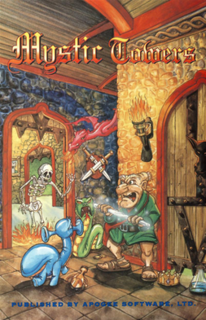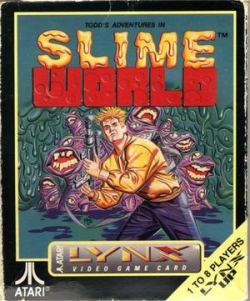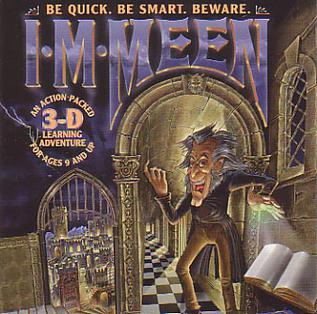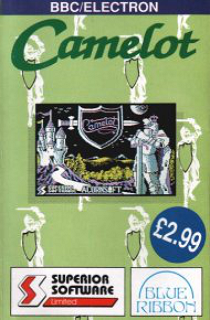
Pathways into Darkness is a first-person shooter adventure video game developed and published by Bungie in 1993, for Apple Macintosh personal computers. Players assume the role of a Special Forces soldier who must stop a powerful, godlike being from awakening and destroying the world. Players solve puzzles and defeat enemies to unlock parts of a pyramid where the god sleeps; the game's ending changes depending on player actions.
Acornsoft was the software arm of Acorn Computers, and a major publisher of software for the BBC Micro and Acorn Electron. As well as games, it also produced a large number of educational titles, extra computer languages and business and utility packages – these included word processor VIEW and the spreadsheet ViewSheet supplied on ROM and cartridge for the BBC Micro/Acorn Electron and included as standard in the BBC Master and Acorn Business Computer.
Warhammer Quest is a fantasy dungeon, role-playing adventure board game released by Games Workshop in 1995 as the successor to HeroQuest and Advanced HeroQuest, set in its fictional Warhammer Fantasy world. The game focuses upon a group of warriors who join together to earn their fame and fortune in the darkest depths of the Old World.

Mystic Towers is a video game created by Australian developer Animation F/X and published by Manaccom domestically and Apogee Software internationally. Originally exclusive to MS-DOS compatible operating systems, it was re-released on Steam in 2015 with Microsoft Windows and Mac OS support. It stars Baron Baldric, an old wizard with a magic staff and an array of amusing mannerisms, who must quest through twelve towers and rid them of monsters. Mystic Towers is a sequel to Baron Baldric: A Grave Adventure, a platform game in which Baron Baldric battled an evil sorcerous ancestor.

The Guardian Legend is a 1988 hybrid action-adventure/shoot 'em up video game developed by Compile for the Nintendo Entertainment System (NES). It is the sequel to the 1986 MSX game Guardic, and was published and released in Japan by Irem in 1988, in North America by Broderbund in 1989, and in Europe by Nintendo in 1990.

In Search of the Unknown is a module for the Dungeons & Dragons roleplaying game, designed for use with the Basic Set of rules. It was written by game designer Mike Carr and was first published in 1978 by TSR, Inc. The module details a hidden complex known as the Caverns of Quasqueton. Reviewers considered it a good quality introduction to the game that was written in the so-called dungeon crawl style, where the primary goal of the players is the exploration of a dangerous labyrinth to battle monsters and obtain treasure.
The Eggerland (エッガーランド) series consists of several puzzle games developed by HAL Laboratory. Its first release was in 1985 for MSX computer systems. Many titles were made in the series and the gameplay is almost exactly the same in every game as well. Only a few changes were made over the years.

Space Dungeon is a multidirectional shooter released in arcades by Taito in 1981. Designed and programmed by Rex Battenberg, it was available both as a conversion kit and full arcade cabinet. An Atari 5200 port was released in 1983.

Todd's Adventures in Slime World is a side-scrolling platform video game first released for the Atari Lynx in 1990, with Sega Genesis and PC Engine Super CD-ROM² versions following in 1992.

Qwak is a 2D puzzle-platform game developed by Jamie Woodhouse. It was initially released for the BBC Micro and Acorn Electron in 1989 as part of Superior/Acornsoft's Play It Again Sam 10 compilation. An updated and enhanced Amiga version was given a budget release by Team17 in 1993. This update added several new features, including a two player mode and additional levels. The game was re-released on the Amiga CD32 later that year in a double-pack with science fiction shooter Alien Breed.

Advanced Dungeons & Dragons is an Intellivision game; it was one of the first Advanced Dungeons & Dragons games to be licensed by TSR, Inc. It was later retitled to Advanced Dungeons & Dragons: Cloudy Mountain to distinguish it from the sequel, Advanced Dungeons & Dragons: Treasure of Tarmin. It is the first Intellivision cartridge to use more than 4K of ROM.

Dungeon! is an adventure board game designed by David R. Megarry and first released by TSR, Inc. in 1975. Additional contributions through multiple editions were made by Gary Gygax, Steve Winter, Jeff Grubb, Chris Dupuis and Michael Gray. Dungeon! simulates some aspects of the Dungeons & Dragons (D&D) role-playing game, which was released in 1974, although Megarry had a prototype of Dungeon! ready as early as 1972.

Snapper is a clone of the Namco arcade game Pac-Man programmed by Jonathan Griffiths for the BBC Micro and released as one of the launch titles for Acornsoft in 1982. It was also one of Acornsoft's launch titles for the Acorn Electron in 1983.

Kwirk, known in Japan as Puzzle Boy, is a puzzle video game developed and published by Atlus in Japan on November 24, 1989 for the Game Boy. The game was later published in North America in March 1990 by Acclaim Entertainment. On February 22, 1991, Atlus ported and released Puzzle Boy to the PC Engine/TurboGrafx-16 in Japan.

Pipeline is a video game for the BBC Micro and Acorn Electron, originally published by Superior Software in 1988. It is an overhead view action role-playing game set on a mining platform. It was remade for Microsoft Windows as Pipeline Plus (2004).

I.M. Meen is a 1995 fantasy educational game for DOS to teach grammar to children. It is named for its villain, Ignatius Mortimer Meen, a "diabolical librarian" who lures young readers into an enchanted labyrinth and imprisons them with monsters and magic.
Dunjonquest is a series of single-player, single-character fantasy computer role-playing games by Automated Simulations. Temple of Apshai was the most successful and most widely ported game in the series. The games relied on strategy and pen & paper RPG style rules and statistics.

Camelot is a computer game written by Tony Oakden and published in the UK in 1989/90 for the BBC Micro and Acorn Electron. The game was first published by Superior Software and Acornsoft as part of the Play it Again Sam 9 compilation in 1989 and was subsequently re-published as a standalone title in 1990 by Superior Software and Blue Ribbon.

Dungeon of the Endless is a roguelike tower defense game developed by Amplitude Studios. It is the third game of their loosely connected Endless series, which includes Endless Space and Endless Legend. It was released in October 2014 for Microsoft Windows and Mac OS X systems, August 2015 for iOS devices, and for Xbox One in March 2016. The PlayStation 4 and Nintendo Switch ports were released in May 2020. A revamped version for iOS and Android devices, called Dungeon of the Endless: Apogee, launched on March 16, 2021.















